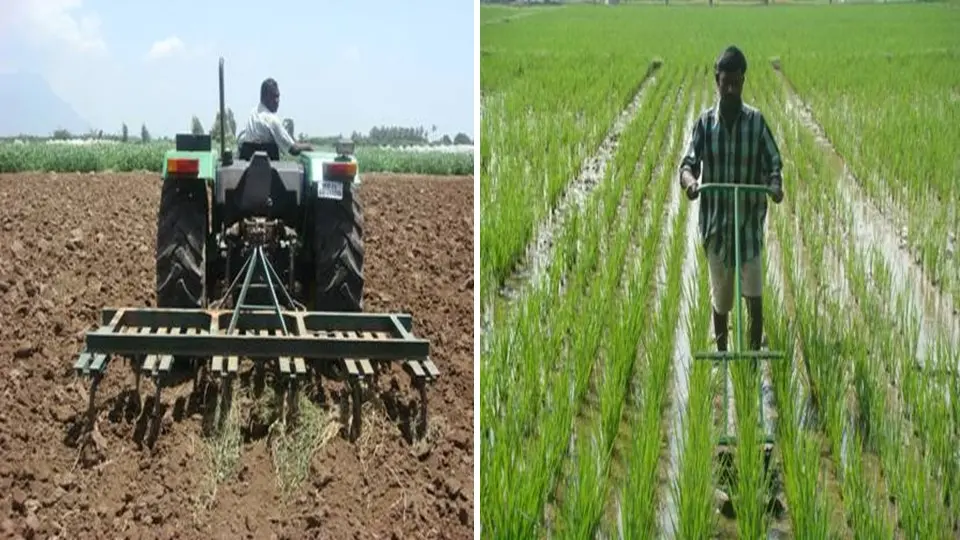Tillage system in agriculture

Tillage system-
After the harvest of the crop or even under fallow conditions, soil becomes hard and compact due to beating action of rain drops, irrigation, drying, movement of implements and labour. Weeds and stubbles are also present. Such conditions are not suitable for the placement of seed and growth of crop plants. Seed needs loose friable soil, free of weeds and stubbles for placement and germination. Thus tillage operations are required to create conducive condition for seed germination and plant development.
Tillage is the oldest and most fundamental activity of man for crop production. It is one of the forms of management of soil, water, nutrient, crop and pests. The word tillage is derived from the Anglo-Saxon words ‘Tilian’ and ‘Teolian’, meaning to plan and prepare the soil for seed to sow, cultivate and raise crops. Tillage consists of breaking hard compact surface to a certain depth and other operations that are followed for bringing the soil in a good physical condition for plant growth. Therefore tillage is a practice by which a good tilth can be maintained.
Tillage operations are done to prepare a fine seed-bed for sowing. Tillage creates improved physical conditions of the soil that results in better water nutrient and temperature – relationship and reduces root impedance. It enables accurate – placement of seed and fertiliser and – controls weeds. Tillage helps replace natural vegetation with useful crops E. and is necessary to provide favourable soil environment for establishment, growth and yield of crop plants. Thus, tillage can be defined as the mechanical manipulation of soil for creation of friable surface that will enable seeds to germinate and plants to grow and develop in an ideal state.
Objectives of Tillage System
Tillage is one of the most expensive farm operation in raising crops. The tillage operations are performed for the following purposes:
- To prepare the seed-bed: The operation cuts, heaves and shatters the dense soil to a desirable depth and breaks the clods and crust to a desirable extent for a suitable seed-bed or main field.
- To improve soil structure aeration, infiltration, permeability and root penetration: It decreases run-off and erosion.
- To incorporate crop residue, green manure, organic manure, fertilisers, amendments and soil conditioners.
- To prepare soil mulch and conserve soil moisture.
- To improve availability of nutrients by increasing the decomposition of organic matter.
- To improve aeration and help in reducing residual effect of pesticides.
- To obtain precision levelling of land for irrigation and other operations.
- To control weeds by uprooting, desiccating, decomposing and merely by weakening the weed 1 plants through dislodging, damping, root pruning or other injuries.
- To reduce or eliminate weed-crop competition for moisture, nutrients, light and carbon dioxide, thereby improving plant growth
- To perform summer deep ploughing that exposes the land to bright sunshine and destroys soil- borne insects, pathogens, larger soil animals including rodents and worms.
- To provide better anchorage to crop plants and greater space for underground development of storage roots and stem.
Disadvantages of Tillage
- If field is not prepared within the required period, the soil may either lose or gain moisture and become unworkable, or when the sowing season is delayed, especially in heavy soils.
- Tillage operations performed beyond or below the optimum soil moisture level cause deterioration of physical conditions.
- Tillage operations with heavy equipments result in formation of hard pan below the tilled layer.
- Excessive tillage pulverizes soil too much and results in water and wind erosion.
- Excessive tillage destroys the soil structure (arrangement of soil particles).
- Excessive tillage increases the rate of oxidation of organic matter due to exposure to sunlight.
Tilth
Tilth is the physical condition of soil in relation to the plant growth resulting from tillage. It indicates two important properties of soil, viz. the size distribution of aggregates and mellowness or friability of the soil. It permits adequate aeration and rapid infiltration of rain water, and offer little resistance to root penetration. Soil tilth is not static but changes rapidly and markedly with a slight change in moisture content of the soil
Good Tilth-
For cultivation practices, following are the properties or characteristics of good tilth (seed-bed):
- When the soil sample is felt between the fingers, the soil granules are soft and friable and crumble under pressure.
- The aggregates should be stable enough to withstand erosion against wind and water.
Types of Tillage System in agriculture
Tillage operations may be grouped into two types on the basis of time period during which they are carried out. They are on-season and off-season tillage. Diagrammatic presentation of various types of tillage is given here.
A-On-season Tillage
Tillage operations done for raising a crop in the same season or at the onset of season are known as on- season tillage. It is of two types, viz. preparatory tillage and inter tillage.
B- Off-season Tillage
Tillage operations done not for immediately raising the crop plants but for conditioning the soil suitably for the forthcoming main-season crop are known as off-season tillage. It includes levelling the land to a desirable grade, leaching to remove salts, and reducing the populations of harmful flora and fauna in the soil. The off-season tillage operations may be post harvest tillage, summer tillage, winter tillage or fallow tillage. Even the tillage operations performed for special purposes such as levelling, subsoiling and contour tillage may be included in this category.
Preparatory Tillage
Tillage operations that are carried out to prepare the seed bed for raising a crop are known as preparatory tillage. Generally, the term preparatory tillage or cultivation and seed bed preparation are used synonymously. It consists of deep opening and loosening of the soil to bring about a desirable tilth as well as to incorporate or uproot the weeds and crop stubbles when the soil is in workable condition. Preparatory tillage is divided into primary and secondary tillage operations.
1-Primary tillage or ploughing :
Ploughing is opening of the compact soil with the help of different ploughs. It includes cutting and inversion of hard soil and separates it from lower layers after the harvest of previous crop or of fallow land. It also uproots the established weeds and stubbles and leaves the soil with clods. The primary tillage may be done once or twice a year in normal-irrigated agriculture and once in 4 to 5 years in dryland agriculture. The ploughing or primary tillage operation should be performed when the soil has workable moisture. When the soil is too dry, it results in large-size clod formation, and when ploughing is done under wet conditions, the soil sticks to the plough, becomes compact, and on drying becomes a hard pan. Soil structure is destroyed and clods on drying become very hard.
The depth of primary tillage may range from 10 to 30 cm, but it mainly depends on effective root-zone depth of the crop. Generally the crops with tap root system require greater depth of ploughing, whereas fibrous or shallow rooted crops need shallow ploughing. The number of ploughings necessary to obtain a good tilth depends the on soil type, weeds and crop residue on ploughing necessary to obtain a good tilth depends on the soil type, weeds and crop residue on soil surface. In heavy soil more number of ploughings (3-5) are required compared with that in light soil, where only 1-3 ploughings are sufficient. Thus ploughing is an important factor in structural management of land and in the maintenance of crop yield.

2-Secondary tillage:
This refers to those lighter or finer tillage operations that are performed on the soil after primary tillage to bring about a good soil tilth. After ploughing the fields are left with large clods, some weeds, partially uprooted stubbles and rootstocks. Therefore in secondary tillage the soil is not inverted, rather it is stirred, clods are crushed and the remaining weeds, stubbles and root stocks are uprooted. The soil is made friable and mellow, and the desired tilth is obtained with the use of disc harrow, cultivator and blade harrow. Planking is done to break hard clods, and level, smoothen and compact the soil slightly. Thus the field is made ready for sowing after primary tillage = (ploughing), followed by secondary – tillage (harrowing, and planting). Later this well-prepared seed-bed is laid out for irrigation channels, planting method and direction. Crops like wheat, barley, pulses, and oilseeds are sown on flat bed and no treatment is given. But the crops like sugarcane, potato, root crops, tobacco, tomato etc. are sown in furrows. Depending on row spacing the furrows are made and sowing is done.

Inter-tillage
The tillage operations that are carried out in the standing crop, i.e. after sowing or planting, and prior to harvesting of crop are called inter tillage. This is also known as inter- cultivation or post-seeding or post- planting cultivation. It includes cultivating, harrowing, hoeing, weeding, earthing-up, ridging and furrowing. Inter tillage is shallow in nature and keeps the field free from weeds for a significant period of time. It helps incorporate the top dressed manures and fertilisers to earth-up and to prune roots.
Inter-tillage provides weed-free field, better aeration and extra support against lodging (as in sugarcane); more soil volume for better growth of tubers (as in potato); and facility for irrigation (as in vegetables). Inter-tillage may be done manually or with the use of bullock-drawn implements like blade harrow, spike and spring-tooth harrow and rotary hoes, between the crop rows to control weeds.
Minimum Tillage
The average cost of tillage is estimated at 16 per cent of value of the crop produced, and half the tillage required is necessary to control weeds. Thus the farmer looses about 8 per cent the value of produce annually because of tillage needed to control weeds, which can be reduced by substituting with herbicides and other methods. In this regard the concept of minimum or 0 tillage was started in the USA.
Minimum tillage can be defined as a group of soil-preparation methods for planting, in which the number of operations over the field is less than that in conventional tillage, or it is referred to as growing a crop using only a tillage operation needed to place and cover the seed at proper depth. It is carried out with the help of several specially designed implements.
Zero or No Tillage
In Zero tillage no operation is performed before and after sowing a crop. Zero tillage refers to planting of crop directly in the field without much tillage operations. The no-tillage treatment consists of killing a sod (grass, legume) with herbicides and planting seed like maize by removing soil plug with a soil-sampling tube, dropping the seed in holes and filling the holes with the soil. No post- planting cultivation is carried out. Chemical weed control is followed. The basic requirements for success of Zero tillage or no-tillage planting system are (a) effective herbicide, (b) no tillage planting (c) right type of soil, and (d) adequate plant residues.
Benefits of Zero or no tillage planting
- It helps in conserving soil moisture, particularly in arid and semi-arid conditions.
- It prevents soil erosion by wind and water. The crop residue serves as mulch on the soil and acts as barrier for soil movement.
- It maintains proper soil structure. Excessive tillage may slowly disrupt the structure and consequently reduces water-holding capacity of soil. Minimum tillage prevents this possibility.
- It saves the time of field preparation, and allows timely planting of crops in multiple and relay cropping systems.
- It conserves the fuel.
Join Times of Agriculture
Get the latest Agriculture Magazine and regular important updates right on your phone.
👉 Join WhatsApp Group